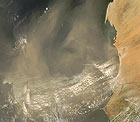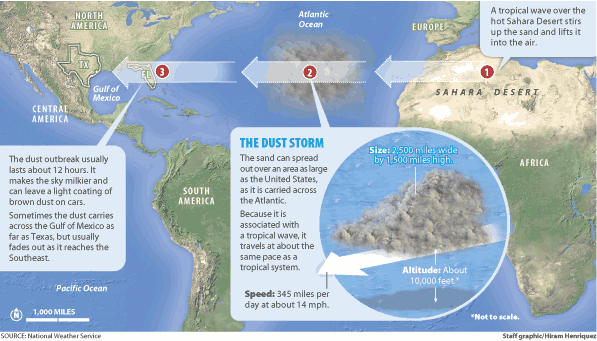Red Dust on your Car?
Written July 23, 2005
Many stories will be placed in the news to explain the unusual, but should we dig deeper to come to another conclusion? The idea of red dust being deposited on cars in the southern part of the United States raises a flag. The latest satellite image dictates a cloud now off the coast of Africa composed of tan to light brown sand. Is this not the color we see in news clips from Iraq and in movies documenting the Sahara? Since when is sand red and if it is the source is not of this Earth, but that rogue cloud of debris now being picked by NORAD space radar now drifting slowly towards our atmosphere. Timing is everything and scientist on earth are confused as to the many aspects of particle movement and the forces that affect its movement and dispersal. Notice the diagram of dust storm movement quotes only brown dust without the mention of red or iron oxide like the article below.
All Rights Reserved: © Copyright 2005
This is reproduction of the Sun Sentinel Page Below
| HOME | NEWS | SPORTS | ENTERTAINMENT | SHOPPING | CLASSIFIED | BUSINESS | WEATHER |
![]()
S. Florida to
get dusty next week as Sahara sand cloud moves in
By Ken Kaye
Staff Writer
Posted July 22 2005
| As if this
hurricane season wasn't tumultuous enough, South Florida is about to get
hit by a sandstorm. |
 |
By Monday or
Tuesday, a Sahara dust outbreak, or a cloud of what originally was African sand
carried across the Atlantic on the back of a tropical wave, is expected to
settle over the region for about 12 hours, forecasters said.
It might turn the skies milkier and leave a light
coating of reddish-brown dust on your car, the result of a small amount
of iron content. It also could make the sunrise and sunset
spectacular, said Jim Lushine of the National Weather Service in Miami.
"It's just kind of an interesting phenomenon," he said. "You
might see it better in the morning, when the angle of the sun is low."
Usually, such dust clouds are too diluted to cause health problems or reduce
visibility for aircraft pilots.
On the other hand, if concentrated enough, the outbreak could raise the air
quality index into the unhealthy range for people with respiratory problems,
said Ken Larson, a natural resource specialist with the Broward County
Environmental Protection Department.
"If there are adverse concentrations, we would put out a health
advisory," he said. "If somebody is subject to a respiratory
condition, if they see hazy skies, they might want to take a little more
precaution, not participate in strenuous activity and stay indoors."
Dust outbreaks, which are most common in early July, start when tropical waves
lift sand from the Sahara to about 10,000 feet, where it is reduced to even
smaller particles. The dust then drifts west on a dry tropical wave, as opposed
to a moist tropical wave, which can spin into a hurricane.
The dust cloud aiming this way is huge, about 2,500 miles from west to east and
1,500 miles from north to south, or almost as big as the United States, Lushine
said.
South Florida should see its western edge, which is where the tropical wave is
embedded, but "they'll notice it more in the Caribbean, like in San
Juan," Lushine said.
By today, the outbreak should be about 1,400 miles east of Miami, moving west at
345 miles per day, about the same pace as a tropical system.
Because the Sahara dust carries some pathogens, it might cause harm to coral
reefs, particularly in the Caribbean, said Bernhard Riegl, an associate
professor at Nova Southeastern University's Oceanographic Center. Those
pathogens, he said, include fungi, spores and bacteria, but the dust can haul
even bigger objects. "Entire desert locusts, the insects, have made it
across the Atlantic to the Windward Islands."
So far, there is no evidence the pathogens harm humans, although on the
Caribbean island of Trinidad an abnormal number of infants have asthma problems,
he said.
One good side effect: "It's difficult for tropical storm development to
occur in these dust outbreaks," Lushine said.
Ken Kaye can be reached at kkaye@sun-sentinel.com.Dust storm over
the Mediterranean Sea and Greece
See
larger image
(AP/NOAA)
Jul 22, 2005
